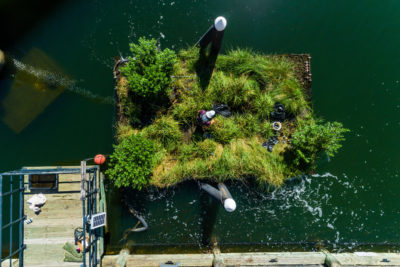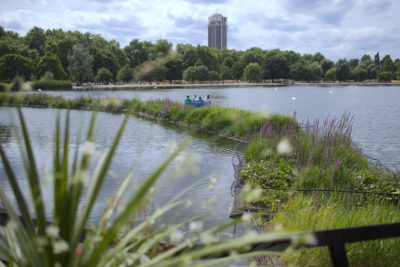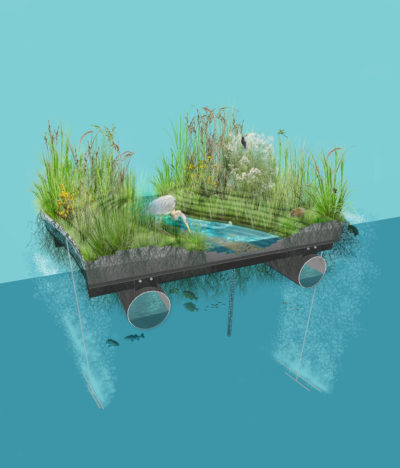5 small islands roughly the scale of yard swimming swimming pools float subsequent to the concrete riverbank of Bubbly Creek, a stretch of the Chicago River named for the fuel that after rose to the floor after stockyards dumped animal waste and byproducts into the waterway. Clumps of brief, native grasses and vegetation, together with sedges, swamp milkweed, and queen of the prairie, rise from a gravel-like materials unfold throughout every synthetic island’s floor. Just a few rectangles reduce from their middles maintain bottomless baskets, buildings that may, challenge designers hope, present an attachment floor for freshwater mussels that after flourished within the river.
Three thousand sq. ft in whole, these synthetic wetlands are a part of an effort to wash up a portion of a river that has lengthy served the pursuits of business. This floating wetland challenge is one in all many proliferating around the globe as cities more and more look to inexperienced infrastructure to deal with poisonous legacies. In america, researchers are conducting experiments in Boston and Baltimore in addition to in Chicago, every staff sharing greatest practices with the opposite to maximise the ecological advantages of their techniques. The Canadian authorities and native municipalities are allotting extra funding for modern initiatives. Floating wetlands are additionally multiplying in the UK, and research to quantify extra advantages proceed in Australia and Brazil.
Floating wetlands filter contaminants and take up extra agricultural vitamins that may result in algal blooms and lifeless zones.
Like pure wetlands, floating variations present a spread of ecosystem providers. They filter sediment and contaminants from stormwater, and laboratory experiments present that some vegetation have the power to lock up some chemical compounds and metals present in acid mine drainage. These techniques take up extra agricultural vitamins that may result in algal blooms and lifeless zones, and up to date analysis suggests they may very well be used to scale back artifical contaminants that persist within the setting. Although it’s tough to quantify the precise advantages these techniques supply, they usually have limitations as a instrument in remediating polluted waterways, they may present an alternative choice, researchers say.
Nick Wesley, government director of City Rivers, a nonprofit working with the Shedd Aquarium on the Chicago challenge, believes floating techniques are a pure match for the city setting. Many urbanized river techniques, he says, have the identical “metal sheet pile wall, some rough-wrap riprap on the sides. We’re attempting to [restore] what the naturalized river could be.” In lots of cities, he continues, floating wetlands may present a low-cost various to traditional infrastructure initiatives as a result of they’re modular and simple to put in and to observe.
Wesley’s group started, in 2018, with a floating wetlands challenge on the Chicago River’s North Department. Known as the Wild Mile, the set up goals to enhance water high quality and has already begun attracting invertebrates, together with mollusks and crustaceans. Final month, the group expanded to the shores of Bubbly Creek. City Rivers, Shedd staff, and a staff of volunteers bolted collectively polyethylene and metallic frames, draped them with matting, dropped them within the water, added vegetation, and anchored the islands to the river backside in order that they keep in place because the roots develop into the water. The vegetation will develop for years to return, a part of a “riverponic” system, as Wesley calls it, that requires no soil or different substrate for help.

A floating wetland in Baltimore’s Interior Harbor put in by the Nationwide Aquarium.
Nationwide Aquarium
Floating wetlands “are having a little bit of a second,” says Richard Grosshans, a analysis scientist with the Worldwide Institute for Sustainable Improvement who works on the floating buildings. “They perform very equally to a pure wetland: they’ve the identical processes, vegetation and microorganisms, micro organism and algae, [which] naturally break down toxins. They take up vitamins and supply habitat. It’s type of frequent sense to these of us who work with these kinds of techniques.”
Floating wetlands had been first examined in retention ponds, the sort usually positioned close to developments to carry stormwater, to see in the event that they filtered air pollution. “The entrance finish of it was, ‘Will they work? How effectively do they work? And what vegetation ought to we advocate?’” says Sarah White, an environmental toxicologist and horticulturalist at Clemson College who has labored on floating wetlands since 2006. Partnering with researchers at Virginia Tech, White discovered that the wetland vegetation she examined not solely did effectively in ponds with numerous nutrient air pollution, however the adaptable, resilient vegetation truly thrived. She didn’t at all times select native vegetation, opting as a substitute for those who would make the islands extra enticing, in order that extra city planners would use them.
Within the early 2010s, Chris Walker, a researcher on the College of South Australia, started testing floating wetlands in wastewater, quantifying the pollution that 4 species of vegetation took up of their tissues and enhancements to water high quality. Two species, twig rush Baumea articulata and the frequent reed Phragmites australis, confirmed the very best uptake of nitrogen and phosphorus of any floating wetland analysis to this point. “That creates an actual alternative for [the] everlasting elimination of sequestered vitamins,” says Walker, who can be the principal scientist for a floating wetland firm known as Readability Aquatic.
One acre of floating wetland can take in the nutrient air pollution from seven to fifteen acres of city improvement, one researcher discovered.
His staff additionally began testing the power of floating wetlands to filter out rising contaminants like per- and polyfluoroalkyl substances (PFAS), which aren’t at all times filtered by remedy vegetation and are linked to elevated levels of cholesterol, issues with reproductive well being, and kidney and testicular cancers. The reed Phragmites australis positioned in a floating wetland started absorbing the pollutant into its tissues in lower than a month.
Islands anchored in cities are giving scientists a chance to review environments which have lengthy been ignored. In Chicago, Austin Happel, a analysis biologist on the Shedd Aquarium, is starting a research on fish close to the floating wetlands in Bubbly Creek. Beginning within the spring, he’ll use acoustic telemetry to tag fish captured close to the wetland and monitor the place they go. By the next yr, he ought to be capable of see in the event that they use the floating wetlands as a buffet or as a spot to cover from predators.
In Boston, Max Rome, a PhD scholar at Northeastern College, is making an attempt to quantify the advantages of wetlands which were floating since 2020 within the Charles River, one other traditionally degraded waterway. He discovered that one acre of wetland can take in the nutrient air pollution — often dumped into the river through stormwater — from seven to fifteen acres of dense city improvement.
Rome can be wanting into whether or not floating wetlands can create small pockets of improved water high quality or habitat that permit sure native species, like freshwater sponges, to regain a toehold within the river. To do this, he monitored water high quality close to the wetlands and in contrast it to different locations within the river.

Floating wetlands on Serpentine Lake in London’s Hyde Park.
Royal Parks
“The final era did a very good job of coping with level supply air pollution — and it was an enormous activity,” he says, referring to the success of the Clear Water Act in lowering effluent from discharge pipes. His era has a brand new job, he provides: grappling with “ecological restoration of those degraded water our bodies on the identical time that we do air pollution discount,” one thing the wetlands may assist tackle.
Regardless of the advantages of floating wetlands, obstacles to widespread adoption stay. They require time and vitality to put in and monitor, they usually may doubtlessly trigger flooding in the event that they change into unmoored and intrude with water movement. A metropolis would additionally want a whole lot of floating wetlands to wash up probably the most polluted stretches of waterways and handle the contaminants that proceed to movement into them.
One other potential disadvantage is the specter of invasive vegetation colonizing a floating wetland, which might then require upkeep. One species that successfully sucked up PFAS within the Australian research, for instance, is an aggressive invader already colonizing wetlands throughout the U.S. As well as, if the purpose of a floating wetland is to completely take away phosphorous and nitrogen from an ecosystem, managers could must take away and compost vegetation in order that they don’t launch the vitamins again into the setting once they go dormant, although ongoing analysis means that biofilms that kind on plant roots and on the underside of wetlands may proceed to take away vitamins even after vegetation begin to senesce. Crops that take away PFAS would seemingly should be incinerated.
The Nationwide Aquarium in Baltimore is planning to develop its 400-square-foot floating wetland to 10,000 sq. ft by 2024.
Nonetheless, say researchers, floating wetlands do profit the setting. “I believe we’re simply on the lookout for yet another instrument in our toolbox to assist handle water high quality,” says Clemson’s White. “This provides us one other place within the panorama the place we are able to even have a expertise that may do it.”
The forms of locations that may very well be improved by these initiatives are rising extra diverse. The Nationwide Aquarium in Baltimore was the primary place within the U.S. to check floating wetlands in a tidal system, and right now 400 sq. ft planted in saltmeadow hay and clean cordgrass float within the metropolis’s Interior Harbor. The challenge has been so profitable at decreasing ranges of vitamins and micro organism and at making a refuge for wildlife — together with American eels, gizzard shad, and ghost anemones — that the aquarium now plans to develop the islands to 10,000 sq. ft in 2024, says Charmaine Dahlenburg, the aquarium’s director of subject conservation.
The Harbor islands are the Nationwide Aquarium’s fourth try at making a thriving wetland system, demonstrating how tough it may be to tailor a floating wetland to a selected location. When the aquarium first put in wetlands in 2010, geese invaded them and ate the vegetation. The same downside occurred with a second model two years later. The third try fared higher, due to fencing that excluded geese, however the fourth iteration — which includes a channel that forestalls algal blooms from killing vegetation — fared the very best.

A rendering of a cross-section of a floating wetland put in in Baltimore.
Nationwide Aquarium
Nationwide Aquarium researchers investigating how the floating wetlands assist mitigate such blooms discovered that microscopic organisms on plant roots and on the underside of the wetlands assist transfer nitrogen from the water and thru the meals chain — from barnacle to crab to fish. There are ecosystem advantages above the waterline, too: Night time herons and otters go to the islands, discovering refuge within the grasses. Analysis on fish, birds, and mammals drawn to floating wetlands shouldn’t be effectively developed, however these buildings clearly present habitat in locations the place buildings, bulkheads, and riprap have changed pure wetlands.
The quantity of contamination that vegetation can take away from aquatic environments relies on the quantity and kind of air pollution, the plant species used, and the scale of the floating wetlands. However some scientists, together with Dahlenburg and Rome, are hoping that as analysis accumulates, authorities companies will think about using such initiatives to mitigate contamination and wetland improvement.
In three Boston-area watersheds, a brand new regulation below the Clear Water Act would require sure business, industrial, and institutional properties with a number of acres of impervious floor to scale back nutrient and bacterial air pollution in stormwater operating off their properties, one thing by no means mandated earlier than. Britain just lately introduced a requirement for properties and water firms to scale back water air pollution. Floating wetlands that do which might be already rising in London, and plans for different areas are within the works.
Rules like these may compel cities to take a extra aggressive strategy to inexperienced stormwater infrastructure. “As that begins to occur,” says Rome, “the function that may be performed by floating remedy wetlands goes to return into focus.”
The rising use of the buoyant, lush gardens — in cities that vary from Australia to Europe to North America — present how even small wetland islands could make a distinction. “Our little postage stamp of a wetland isn’t going to unravel every part,” says Dahlenburg, of the Baltimore challenge. “What we’re attempting to create is that this mannequin city waterfront. We would like different cities to know that there are methods to include pure habitat, to deliver again the ecosystem providers that had been misplaced due to industrial improvement.”
